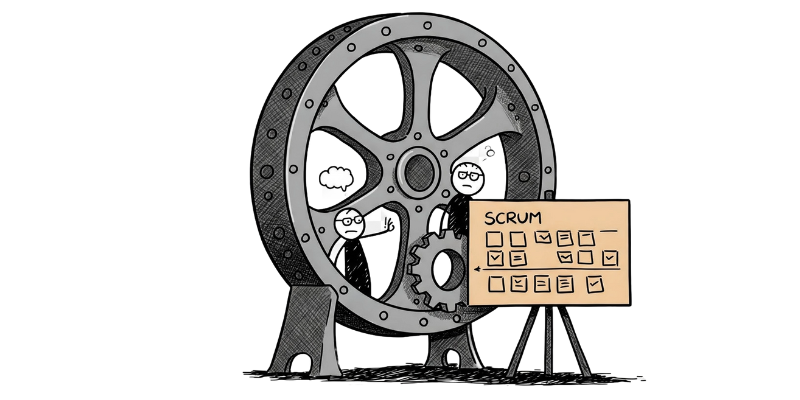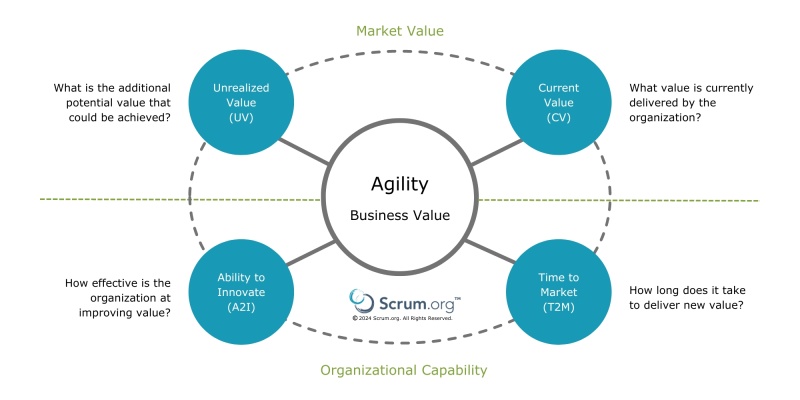
(Mechanical) Scrum is Dead
If you've been poking around on LinkedIn anytime in the past couple of years, you've almost certainly come across some LinkedIn influencers shouting "Scrum is dead!" from their virtual rooftops. And to a degree, they are right - but they are missing a key word in the front of that statement: "Mechanical". "Mechanical" Scrum is dead. You may have also heard this referred to as "Zombie Scrum" (a name I find shockingly accurate and humorous). If you are unfamiliar with this term, Barry Overeem (from The Liberators) defines it as follows:
At first sight, Zombie Scrum seems to be normal Scrum. But it lacks a beating heart. The Scrum teams do all the Scrum events but a potentially releasable increment is rarely the result of a Sprint. The team also doesn't have any intention to improve their situation. Actually, nobody cares about this team. The stakeholders have forgotten the existence of this team a long time ago.
I don't think anybody will disagree that this style of working is less than ideal. In fact, it flat out sucks. This is the type of Scrum that I believe is dead. I'll get into the key points around why this distinction is important, but in order to understand how Scrum became the process villain for all LinkedIn influencers, we need to get an understanding of how we got to this point today.
Where are we today?
While Scrum might feel like a new way of working for a lot of people, its history can actually be traced back to an article written in 1986. Jeff Sutherland and Ken Schwaber (co-founders of Scrum) implemented the first Scrum practices in 1993, and then later in 2001, 17 disgruntled software leaders met in the mountains of Utah for a few days to formally create The Agile Manifesto. They recognized that the inefficiencies and challenges of extensive Waterfall planning and gated handoffs were becoming obsolete.
As soon as companies realized the competitive advantage they could get with Scrum, the market responded and became saturated with Agile expertise. Some organizations began offering certifications within the framework, and companies started hiring these experts to begin their agile transformation.
This is good, right? Don't we want experts to help adopt this framework? And you would be right, but this leads me to the first cause that I believe has led us into the realm of Mechanical Scrum:
The Scrum Master is not an entry level role
As the demand for Scrum expertise increased, the barrier for entry became lower, leading many to believe that getting an entry level Scrum certification was enough to be a Scrum Master. Even today in 2025, I see countless posts on social media with people believing that getting the PSM-I from Scrum.org with 0 delivery experience qualifies them for the role.
The Scrum Master position is hard, and requires tremendous patience and curiosity to be successful. Teams and organizations resist change and prefer their established ways of working, while the Scrum Master is trying to shift this mindset, oftentimes with limited to no authority within the organization. It's a daunting task, but it can be incredibly rewarding for both the team and the organization when done effectively.
Everybody needs to start somewhere, but the Scrum Master role is not for the faint-hearted. Without a deep understanding of the framework and extensive delivery experience, people tend to go through the motions because it's simpler to do so. It's easy to assume that holding a Daily Scrum and operating in Sprints will mean your team has achieved agility. A Scrum Master who goes through the motions will inevitably lead to frustration for everyone involved. They will get frustrated, the team will get frustrated, the stakeholders lose trust, and the customers get minimal value out of it. In other words, Zombie Scrum.
"The Scrum Master position is hard, and requires tremendous patience and curiosity to be successful"
Companies must bring in experienced leaders for this role. Influencing change from a position with little to no authority is no easy task. But finding the right person to fill this role is just one piece of the puzzle. Leadership also has accountability in the process, leading to another issue I've observed.
Scrum requires trust, and trust requires giving up power
Going back to the pre-Agile days of Taylorism, companies became accustomed to operating in a command and control style. For those not familiar with Taylorism, it's an Industrial Era style of management that emphasizes rigid, standardized processes and individual task completion. Do this task to get a reward, and do it incorrectly to get punishment. This tactic is useful when completing simple tasks. But in the creative world of software development, this is a motivation killer.
Scrum emphasizes empowered teams. In order to adapt quickly and deliver to everchanging customer needs, a Scrum team must be empowered and trusted by the organization to make the right decisions.
For Scrum to thrive, leaders need to give up some control to enable self managing teams. This means shifting away from telling the team what to do, to playing more of a support role and empowering them to do the right thing. This is a tough pill to swallow for a lot of leaders. After all, there's a good chance they got to this point in their career by influencing direct control over their teams. But a self-managing and empowered team can be game-changing for organizations when done right.
"In order to adapt quickly and deliver to everchanging customer needs, a Scrum team must be empowered and trusted by the organization to make the right decisions."
There is also accountability put onto the Scrum teams to enable this to work. In order for that trust to be earned, the Scrum teams must deliver high quality frequently and with transparency. Scrum recognizes this, and lucky for us, the framework offers several opportunities to increase this transparency through the Scrum events, the Scrum values, and Scrum accountabilities. With an effective Scrum team, there is no doubt around what the team is doing, why they are doing it, and the value that their customers are receiving. And this leads me to my last point that has led us to Mechanical Scrum.
The need for value-focused evidence
I have started to ask some leaders in the industry how they know their Scrum teams are doing well. Oftentimes this is answered with artificial metrics like "Our velocity is off the charts!" or "We have 25 teams who are all operating with Scrum, each having their own retrospectives!". I wish these were exaggerations, but these are real conversations I've had.
It's important to understand that the goal is not to be Agile in itself. Agile is a means to an end, with that end being the delivery of value for customers.
So what is the goal? When you think about it, a product or service exists to deliver value to end users. And a Scrum team is accountable for delivering value every sprint. It seems simple, but why aren't more companies focusing on the actual value teams are delivering instead of vanity metrics like story points? There is a myriad of reasons, but here are a few issues that I've found to be common:
- Scrum teams aren't empowered for the full product. The developers develop, the testers test, and the business does business. There is no transparency or collaboration around what the full team is doing, or how it's helping their end users.
- Scrum teams aren't delivering frequently enough. They finish development work in one sprint, do testing in another sprint, and wait for user acceptance or systems integration testing in some future sprint. Customer needs change a lot, and even more quickly in the Digital Age. Scrum teams must deliver value every sprint so they can quickly validate and adapt to these needs.
- Leadership seeks to minimize long-term risk instead of maximizing value. It's easy to get stuck in the efficiency trap of trying to become as predictable as possible to hit long-term project timelines and deliverables, while losing focus on quick experimentation and validation of value.
One way to address these issues is to gather evidence around what's stopping you. After all, data is much easier to drive conversations over gut feel.
What I've found to be helpful is a goal-based framework that Scrum.org created called Evidence Based Management. I won't dive into the specific details in this article, but to summarize its intent, you set different levels of goals (Strategic, Intermediate, and Immediate Tactical) that get an organization closer to its Mission and Vision. After you have your goals, you track progress towards these by gathering evidence in 4 Key Value Areas:
- Unrealized Value (what is some potential value we could deliver in the future)
- Current Value (how valuable is the current stuff we've delivered)
- Time to Market (how quickly can we deliver and learn about it)
- Ability to Innovate (what's stopping us from delivering new value)

This framework is currently the best I have found to make sure teams are setting the right goals, running the right experiments, and validating customer outcomes with the right measurables. You must focus in each of these areas to achieve true business agility. Having a great Time to Market but delivering mostly defect fixes is not adding new value for your end users. Focusing on the Current Value of your product without adapting to the Unrealized customer needs in the future will put your organization at a competitive disadvantage (see Blackberry vs iPhone). Evidence Based Management can be the guiding light to making sure your teams are effectively using the Scrum framework.
While evidence is a key component, this is still a goal-driven framework. It's tempting to jump into gathering evidence right away, but you may find it challenging without having the right goals in place. Start there and use the measures to determine how you'll know when you've achieved your goals
Mechanical Scrum is Dead
So in a strange way, I agree with the LinkedIn talking heads that there is a flavor of Scrum that is dead, and that unlovable flavor is Mechanical or Zombie Scrum. The principles behind the Agile Manifesto are still very much alive and relevant, and a truly empowered Scrum team is able to put these principles into practice.
To recap my final thoughts:
- Scrum was created to help teams deliver value in the complex world of software development. Long gone are the days of extensive planning and waterfall delivery.
- Scrum is hard. There are no short cuts, and coaching a Scrum team is not an entry level position. Individuals who are not comfortable with introducing change, failing and adapting over and over again will not likely be a good fit.
- Leadership needs to empower teams, which requires trust. Scrum teams need to earn trust by delivering with quality frequently and transparently.
- Evidence is your friend to know if you're on the right track to your goals. Evidence Based Management is the best framework I've found to help with this.
Are your teams missing that beating heart? Have your stakeholders forgotten the purpose of the team? Reach out to us - let's breathe some life back into the teams, get back to the original intent of Scrum, and improve our customers' lives by delivering value frequently and transparently.